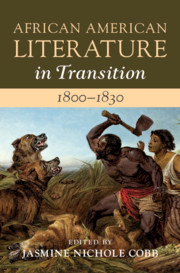Book contents
- African American Literature in Transition, 1800–1830
- African American Literature in Transition
- African American Literature in Transition, 1800–1830
- Copyright page
- Contents
- Figures
- Contributors
- Preface
- Chronology
- Introduction
- Part I Black Organizational Life before 1830
- Part II Movement and Mobility in African American Literature
- Part III Print Culture in Circulation
- Part IV Illustration and the Narrative Form
- Index
Part III - Print Culture in Circulation
Published online by Cambridge University Press: 11 March 2021
- African American Literature in Transition, 1800–1830
- African American Literature in Transition
- African American Literature in Transition, 1800–1830
- Copyright page
- Contents
- Figures
- Contributors
- Preface
- Chronology
- Introduction
- Part I Black Organizational Life before 1830
- Part II Movement and Mobility in African American Literature
- Part III Print Culture in Circulation
- Part IV Illustration and the Narrative Form
- Index
Summary
Essays in part three, “Print Culture in Circulation,” consider the means by which African Americans distributed ideas to mass audiences, including the structures that supported these efforts and the rhetorical tropes that enabled a broad readership. In the earliest decades of the nineteenth century, countless networks organized around African American writing, thinking and speaking fostered literary engagement. Elizabeth McHenry explains that such societies reveal the value of education to free and enslaved African Americans who relied on these associations “for collective reading, writing, and discussion to combat charges of racial inferiority, validate their call for social justice, and alert their audience to the disparity between American ideals and racial inequality.
- Type
- Chapter
- Information
- African American Literature in Transition, 1800–1830 , pp. 167 - 254Publisher: Cambridge University PressPrint publication year: 2021

